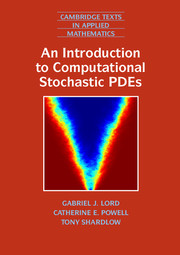4 - Probability Theory
Published online by Cambridge University Press: 05 July 2014
Summary
Solutions to stochastic differential equations are random variables and this chapter develops the concept of random variables. §4.1 reviews probability theory and interprets the notions of measure space and measurable function from Chapter 1 in the probabilistic setting. §4.2 explores the relationship between expectation and least-squares approximation and develops the concept of conditional expectation. §4.3 outlines modes of convergence of random variables and includes the law of large numbers and the central limit theorem. Finally, in preparation for solving stochastic differential equations numerically, §4.4 discusses random number generation and sampling methods for random variables, as well as the ubiquitous Monte Carlo method.
Probability spaces and random variables
Think of an experiment, such as rolling a die or tossing a coin, with an outcome that changes randomly with each repetition. As the experiment is repeated, the frequencies of the outcomes vary and statistical and probabilistic tools are needed to analyse the results. In particular, we assign probabilities to each outcome as a limit of the frequency of occurrence relative to the total number of trials. These ideas are simple and intuitive in an experiment with a finite number of possibilities such as tossing a coin or a die. To express these concepts in an uncountable setting, such as the stochastic processes and random fields arising in the study of stochastic PDEs, we use an abstract measure space (Ω, F, ℙ), called a probability space. We review first the concepts of sample space Ω, σ-algebra F, and probability measure ℙ.
- Type
- Chapter
- Information
- An Introduction to Computational Stochastic PDEs , pp. 137 - 180Publisher: Cambridge University PressPrint publication year: 2014

